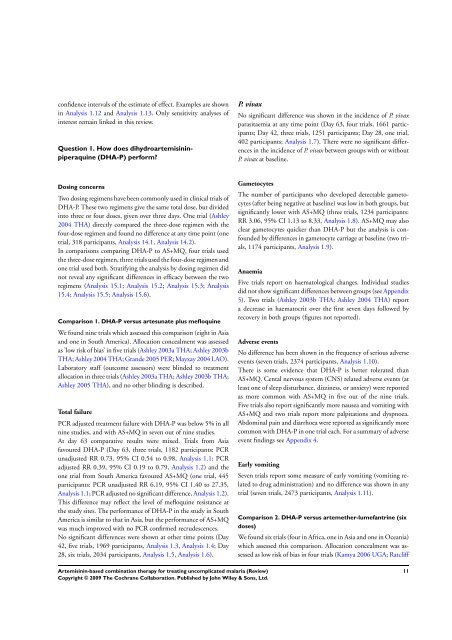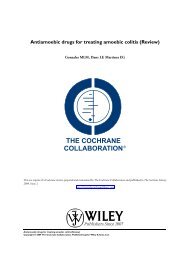Artemisinin-based combination therapy for ... - The Cochrane Library
Artemisinin-based combination therapy for ... - The Cochrane Library
Artemisinin-based combination therapy for ... - The Cochrane Library
You also want an ePaper? Increase the reach of your titles
YUMPU automatically turns print PDFs into web optimized ePapers that Google loves.
confidence intervals of the estimate of effect. Examples are shown<br />
in Analysis 1.12 and Analysis 1.13. Only sensitivity analyses of<br />
interest remain linked in this review.<br />
Question 1. How does dihydroartemisininpiperaquine<br />
(DHA-P) per<strong>for</strong>m?<br />
Dosing concerns<br />
Two dosing regimens have been commonly used in clinical trials of<br />
DHA-P. <strong>The</strong>se two regimens give the same total dose, but divided<br />
into three or four doses, given over three days. One trial (Ashley<br />
2004 THA) directly compared the three-dose regimen with the<br />
four-dose regimen and found no difference at any time point (one<br />
trial, 318 participants, Analysis 14.1, Analysis 14.2).<br />
In comparisons comparing DHA-P to AS+MQ, four trials used<br />
the three-dose regimen, three trials used the four-dose regimen and<br />
one trial used both. Stratifying the analysis by dosing regimen did<br />
not reveal any significant differences in efficacy between the two<br />
regimens (Analysis 15.1; Analysis 15.2; Analysis 15.3; Analysis<br />
15.4; Analysis 15.5; Analysis 15.6).<br />
Comparison 1. DHA-P versus artesunate plus mefloquine<br />
We found nine trials which assessed this comparison (eight in Asia<br />
and one in South America). Allocation concealment was assessed<br />
as ’low risk of bias’ in five trials (Ashley 2003a THA; Ashley 2003b<br />
THA; Ashley2004 THA; Grande 2005 PER; Mayxay 2004 LAO).<br />
Laboratory staff (outcome assessors) were blinded to treatment<br />
allocation in three trials (Ashley 2003a THA; Ashley 2003b THA;<br />
Ashley 2005 THA), and no other blinding is described.<br />
Total failure<br />
PCR adjusted treatment failure with DHA-P was below 5% in all<br />
nine studies, and with AS+MQ in seven out of nine studies.<br />
At day 63 comparative results were mixed. Trials from Asia<br />
favoured DHA-P (Day 63, three trials, 1182 participants: PCR<br />
unadjusted RR 0.73, 95% CI 0.54 to 0.98, Analysis 1.1; PCR<br />
adjusted RR 0.39, 95% CI 0.19 to 0.79, Analysis 1.2) and the<br />
one trial from South America favoured AS+MQ (one trial, 445<br />
participants: PCR unadjusted RR 6.19, 95% CI 1.40 to 27.35,<br />
Analysis 1.1; PCR adjusted no significant difference, Analysis 1.2).<br />
This difference may reflect the level of mefloquine resistance at<br />
the study sites. <strong>The</strong> per<strong>for</strong>mance of DHA-P in the study in South<br />
America is similar to that in Asia, but the per<strong>for</strong>mance of AS+MQ<br />
was much improved with no PCR confirmed recrudescences.<br />
No significant differences were shown at other time points (Day<br />
42, five trials, 1969 participants, Analysis 1.3, Analysis 1.4; Day<br />
28, six trials, 2034 participants, Analysis 1.5, Analysis 1.6).<br />
P. vivax<br />
No significant difference was shown in the incidence of P. vivax<br />
parasitaemia at any time point (Day 63, four trials, 1661 participants;<br />
Day 42, three trials, 1251 participants; Day 28, one trial,<br />
402 participants; Analysis 1.7). <strong>The</strong>re were no significant differences<br />
in the incidence of P. vivax between groups with or without<br />
P. vivax at baseline.<br />
Gametocytes<br />
<strong>The</strong> number of participants who developed detectable gametocytes<br />
(after being negative at baseline) was low in both groups, but<br />
significantly lower with AS+MQ (three trials, 1234 participants:<br />
RR 3.06, 95% CI 1.13 to 8.33, Analysis 1.8). AS+MQ may also<br />
clear gametocytes quicker than DHA-P but the analysis is confounded<br />
by differences in gametocyte carriage at baseline (two trials,<br />
1174 participants, Analysis 1.9).<br />
Anaemia<br />
Five trials report on haematological changes. Individual studies<br />
did not show significant differences between groups (see Appendix<br />
5). Two trials (Ashley 2003b THA; Ashley 2004 THA) report<br />
a decrease in haematocrit over the first seven days followed by<br />
recovery in both groups (figures not reported).<br />
Adverse events<br />
No difference has been shown in the frequency of serious adverse<br />
events (seven trials, 2374 participants, Analysis 1.10).<br />
<strong>The</strong>re is some evidence that DHA-P is better tolerated than<br />
AS+MQ. Cental nervous system (CNS) related adverse events (at<br />
least one of sleep disturbance, dizziness, or anxiety) were reported<br />
as more common with AS+MQ in five out of the nine trials.<br />
Five trials also report significantly more nausea and vomiting with<br />
AS+MQ and two trials report more palpitations and dyspnoea.<br />
Abdominal pain and diarrhoea were reported as significantly more<br />
common with DHA-P in one trial each. For a summary of adverse<br />
event findings see Appendix 4.<br />
Early vomiting<br />
<strong>Artemisinin</strong>-<strong>based</strong> <strong>combination</strong> <strong>therapy</strong> <strong>for</strong> treating uncomplicated malaria (Review)<br />
Copyright © 2009 <strong>The</strong> <strong>Cochrane</strong> Collaboration. Published by John Wiley & Sons, Ltd.<br />
Seven trials report some measure of early vomiting (vomiting related<br />
to drug administration) and no difference was shown in any<br />
trial (seven trials, 2473 participants, Analysis 1.11).<br />
Comparison 2. DHA-P versus artemether-lumefantrine (six<br />
doses)<br />
We found six trials (four in Africa, one in Asia and one in Oceania)<br />
which assessed this comparison. Allocation concealment was assessed<br />
as low risk of bias in four trials (Kamya 2006 UGA; Ratcliff<br />
11








